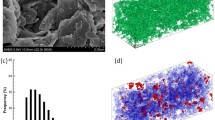The spontaneous imbibition of fracturing fluid in the shale matrix is one of the main reasons for the low hydraulic fracturing flowback rate. The distribution characteristics of fracturing fluid in the shale spontaneous imbibition process are studied by the low field nuclear magnetic resonance (NMR) method. An improved pseudo-potential lattice Boltzmann model is proposed to simulate the spontaneous imbibition behavior in a three-dimensional porous shale structure. The results show that the viscosity, sample length, and permeability of the imbibition solution have an important influence on the imbibition characteristics of the samples. In the imbibition process based on the SC-LBM model, due to the capillary force effect, the imbibition liquid preferentially enters the larger pores of the wetting phase and then gradually distributes in the adjacent pores.





Similar content being viewed by others
References
V. H. DiStefano, M. C. Cheshire, J. McFarlane, et al., "Spontaneous imbibition of water and determination of effective contact angles in the Eagle Ford Shale Formation using neutron imaging," J. Earth Sci., 28(05), 874-887 (2017).
A. Javaheri, H. Dehghanpour, and J. M.Wood, "Tight rock wettability and its relationship to other petrophysical properties: a Montney case study," J. Earth Sci., 28(02), 381-390 (2017).
I. O. Kohshour, R. Barati, M. C. Yorro, et al., "Examination of water management challenges and solutions in shale resource development - could waterless fracturing technologies work?" J. Earth Sci., 28(05), 933-948 (2017). Sci., 28(05), 933-948 (2017).
D. Birdsell, H. Rajaram, and G. Lackey, "Imbibition of hydraulic fracturing fluids into partially saturated shale," Water Resour. Res., 51(8), 6787-6796 (2015).
E. Ghanbari and H. Dehghanpour, "Impact of rock fabric on water imbibition and salt diffusion in gas shales," Int. J. Coal Geol., 138, 55-67 (2015).
C. Pan, M. Hilpert, and C. T. Miller, "Pore-scale modeling of saturated permeabilities in random sphere packings," Phys. Rev. Stat. Nonlin. Soft Matter Phys., 40(1) 62-74 (2004).
P. Raiskinmaki, A. Shakib-Manesh, A. Jasberg, A. Koponen, J. Merikoski, and J. Timonen, "Lattice-Boltzmann simulation of capillary rise dynamics," J. Stat. Phys., 107(1), 143-158 (2002).
L. Chen, Q. Kang, B. Robinson, Y. He, and W. Tao, "Pore-scale modeling of multiphase reactive transport with phase transitions and dissolution-precipitation processes in closed systems," Phys. Rev., 87(4), 043306 (2013).
Q. Li, K. H. Luo, Q. J. Kang, Y. L. He, Q. Chen, and Q. Liu., "Lattice Boltzmann methods for multiphase flow and phase-change heat transfer," Phys. Fluids, 52, 62-105 (2016).
X. Shan and H. Chen., Kinetic theory representation of hydrodynamics: a way beyond the Navier-Stokes equation," J. Fluid Mech., 47(3): p. 1815-1819(1993).
E.M. Chapman, J. Yang, J.P. Crawshaw, E.S. Boek., "Pore-scale models for imbibition of CO2 analog fields in etched micro-modeling," Energ. Proc., 37, 3580-3686 (2013).
P. Li and B. Berkowitz, "Characterization of mixing and reaction between chemical species during cycles of drainage and imbibition in porous media," Adv. Water Resour., 130, 113-128 (2019).
Y. Liu, J. Cai, M. Sahimi, and C. Qin, "A study of the role of microfractures in counter-current spontaneous imbibition by lattice Boltzmann simulation," Transp. Porous Media, 133, 313-332 (2020).
S. Suo, M. Liu, and Y. Gan, "Fingering patterns in hierarchial porous media," Phys. Rev. Fluids, 5, 034301 (2020).
K. Kitamura, F. Jiang, A. J. Valocchi, S, Chiyonobu, T. Tsuji, and K. T. Christensen, "The study of heterogeneous twophase flow around smallscale heterogeneity in porous sandstone by measured elastic wave velocities and lattice Boltzmann method simulation," JGS Solid Earth, 119(10), 7389-7991 (2014).
A. Gunde, T. Babadagli, S. S. Roy, and S. K. Mitra, "Pore-scale interfacial dynamics and oil-water relative permeabilities of capillary driven counter-current flow in fractured porous media," J. Pet. Sci. Eng., 103, 106-114 (2013).
M. Meng, H. Ge, W. Ji, X. Wang, and L. Chen, "Investigation on the variation of shale permeability with spontaneous imbibition time: Sandstones and volcanic rocks as a comparative study," J. Nat. Gas Sci. Eng., 27, 1546-1554 (2015).
Acknowledgments
The study has been performed with the financial support of the National Key R & D Program of China (2016YFC0600705), National Major Project for Science and Technology of China (2017ZX05003-006), National Natural Science Foundation of China (Grant No. U1562217, 51679251, 51727807), China Postdoctoral Science Foundation (Grant No. 2017M610877), and National Science and Technology Major Project on Oil and Gas (No.2017ZX05013001).
Author information
Authors and Affiliations
Corresponding author
Additional information
Translated from Khimiya i Tekhnologiya Topliv i Masel, No. 2, pp. 100 — 105, March — April, 2021.
Rights and permissions
About this article
Cite this article
Cheng, H., Zhang, J., Leng, R. et al. Mechanism of Imbibition in Shale Pores Based on Imbibition Nuclear Magnetic Experiment and LBM Method. Chem Technol Fuels Oils 57, 387–395 (2021). https://doi.org/10.1007/s10553-021-01257-4
Published:
Issue Date:
DOI: https://doi.org/10.1007/s10553-021-01257-4




